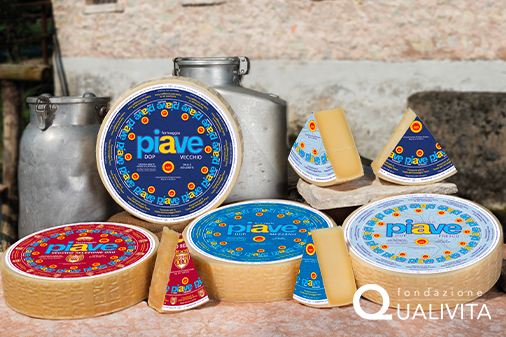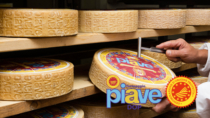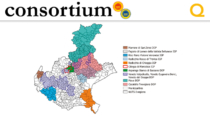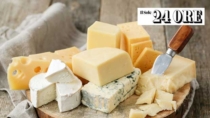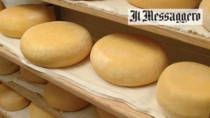Description
Piave PDO is a cooked hard cheese obtained through the processing of cow’s milk, at least 80% of which is from the Bruna Italiana, Grigio Alpina, Pezzata Rossa Italiana and Frisona Italiana breeds, reared exclusively in the production area. It is produced in the following typologies: Fresco (fresh), Mezzano (semi-mature), Vecchio (mature), Vecchio Selezione Oro and Vecchio Riserva.
Production Area
The production area of Piave PDO is within the entire territory of the Province of Belluno, in the Veneto region.
Production Method
At least 70% of the forage and 50% of the dry substances which the cows are fed must come from the production area. Milk and whey starter cultures, produced from the raw milk or whey obtained during processing, are added to the milk. It is then curdled, with the addition of rennet, after which the curd is cooked and put in moulds for shaping. The wheels are pressed until they obtain the correct level of firmness and moisture. This is followed by a period of pre-ripening, where the cheese is wrapped in the marking mould and placed on special frames at controlled temperature and humidity. After salting, which takes place in brine, the cheeses are taken to storerooms with controlled temperature and humidity for ripening, which can last for 20 days to 18 months, depending on the type of cheese. Due to the natural production and ripening process, Piave PDO is lactose-free.
Appearance and Flavour
Piave PDO has a cylindrical shape; the rind of the fresh cheese is soft and light in colour, gradually hardening and getting darker with ageing. The cheese doesn’t have eyes and the fresh variety is white and uniform, while the mature cheese is straw-yellow and has a grainy and crumbly texture, with a characteristic layering in the more mature cheeses. The fresh cheese has a sweet, milky flavour, which becomes more sapid and intense with ripening, without being piquant.
History
Dairy production in the Province of Belluno boasts ancient origins. The development of dairy cattle farming took place at the same time as the decline of the Most Serenissima Republic of Venice, in around the mid-18th century, when the local economy needed a valid alternative to the exploitation of natural forest resources. At the beginning of the industrial era, in the second half of the 19th century, the crisis caused by emigration and the degradation of the mountain areas led to the establishment of the first social milk cooperatives, known as turnarie, which aimed to reduce production costs. Over time, this system became of significant importance in the socio-economic context of the area.
Gastronomy
Piave PDO is best kept in a cool, dry place, and if sliced it should be put in the least cold compartment of the refrigerator until it is eaten. The Mezzano variety is excellent when diced or sliced in dishes such as soufflé; the Fresco variety melts beautifully and is ideal for making pancakes or leek soup; Piave PDO Vecchio is ideal for using in savoury flans or vegetable risottos. A traditional Belluno dish is formai frit, which consists of fried cheese with polenta and kraut.
Marketing
The product is marketed as Piave PDO, in the following typologies: Fresco (aged for 20-60 days); Mezzano (aged for 61-180 days); Vecchio (aged for over 180 days); Vecchio Selezione Oro (aged for over 12 months); Vecchio Riserva (aged for over 18 months). It is sold year-round, whole or in wedges, in 300 g pieces in modified atmosphere packaging, and 500 g and 1 kg pieces that are vacuum-packed.
Distinctive Features
The distinctive organoleptic properties of Piave PDO are given to the high quality of the milk and the use of natural milk and whey starters produced at the dairy.





